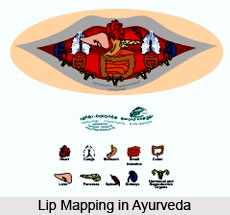 Lip diagnosis in Ayurveda plays an important role in analysing various ailments and applying the proper healing method. Just like other features of the body such as eyes, face, nails and tongue, the lips are also crucial in mirroring the health of the body and disorders of various physical organs. Different features of the lips viz. size, contour, colour, surface and shape must be observed carefully to figure out different disorders. Rough and dry lips indicate a vata derangement or dehydration. Tremors or dryness or lips is also caused due to fear and nervousness. Pale lips of an individual signify a person suffering from anaemia. The lips of a person becomes blackish-brown owing to chronic smoking.
Lip diagnosis in Ayurveda plays an important role in analysing various ailments and applying the proper healing method. Just like other features of the body such as eyes, face, nails and tongue, the lips are also crucial in mirroring the health of the body and disorders of various physical organs. Different features of the lips viz. size, contour, colour, surface and shape must be observed carefully to figure out different disorders. Rough and dry lips indicate a vata derangement or dehydration. Tremors or dryness or lips is also caused due to fear and nervousness. Pale lips of an individual signify a person suffering from anaemia. The lips of a person becomes blackish-brown owing to chronic smoking.
A chronic pitta derangement and the presence of herpes can be figured out by observing the repeated attacks of inflammatory patches along the margins of the lips. Multiple pale brown spots on the lips are indicative of worms in the colon or poor digestion. The lips often become yellow in case a person is afflicted with jaundice. If the lips of an individual become blue it reflects heart disorders and occurs due to lack of oxygen in the lips. Similarly disorders in different organs causes discolouration of various area of lips. A person with vata constitution has thin and dry lips while one having pitta constitution has red lips. Thick and oily lips signify kapha lips.
This article is a stub. You can enrich by adding more information to it. Send your Write Up to content@indianetzone.com





